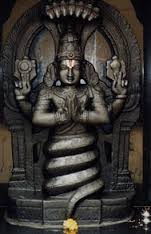This past Friday I had the fortunate opportunity to hear visiting yogi James Boag entertain and enlighten a small group of us at our local Lulu Bandha’s yoga center with stories with about the birth of Ganesha, first child of Shiva and Parvati. And, as James is a cosmic guy, the stories fit right into our on-going theme of working with obstacles and discovering skillful means of transforming their energies. In the Indian tradition, Ganesh is the ultimate remover of obstacles.
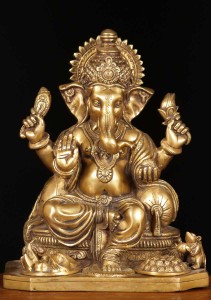 There are several variations on the story of Ganesha’s birth. Click here for a short one. James’ version was much more detailed and nuanced, and included Shiva’s ace warrior, Vira Bhadra, well celebrated by the asana crowd. In James’ version, Vira Bhadra is the one who lops of Ganesha’s head, not Shiva. Ganesha had easily defeated all the other warriors Shiva sent to bring back Parvati. But Vira Bhadra, no ordinary warrior, has the power of 360 vision, symbolizing the wisdom of experience and maturity. Ganesh, being youthful, never sees him coming, as he has locked into a single idea (his mother must not be disturbed), and gets stuck there. This is the immaturity of youth, which costs him his head! When Ganesh gains a new head, that of an elephant, it symbolizes a new maturity, and Ganesh has become one of the most popular of all the Indian deities
There are several variations on the story of Ganesha’s birth. Click here for a short one. James’ version was much more detailed and nuanced, and included Shiva’s ace warrior, Vira Bhadra, well celebrated by the asana crowd. In James’ version, Vira Bhadra is the one who lops of Ganesha’s head, not Shiva. Ganesha had easily defeated all the other warriors Shiva sent to bring back Parvati. But Vira Bhadra, no ordinary warrior, has the power of 360 vision, symbolizing the wisdom of experience and maturity. Ganesh, being youthful, never sees him coming, as he has locked into a single idea (his mother must not be disturbed), and gets stuck there. This is the immaturity of youth, which costs him his head! When Ganesh gains a new head, that of an elephant, it symbolizes a new maturity, and Ganesh has become one of the most popular of all the Indian deities
As in all Indian mythology, the Ganesha story and his imagery is loaded with layers of meaning. Here are some of the aspects of Ganesha relevant to us and represented in his iconography.
1. His broad crown is an invitation to think big. (Do not settle for less than ‘Moksha’ or Enlightenment. Go ‘all in’ on the awakening process.)
2.The tiny eyes speak of the importance of concentration and attention to detail for success in any foray. Clarity, alertness and discrimination are key skills in the world of form. The Universe sometimes speaks in subtleties, and every layer of reality is alive with hints and clues to deepening the awakening process. And remember, the hints may not necessarily be pleasant or easy to accept either.
3. The huge elephant ears and small mouth suggest listening more and talking less. Listening at all levels, gaining sensitivity in all sensory modalities, and the extra-sensory ones as well, takes practice (sadhana). Continually dropping our own beliefs and thoughts to rest in emptiness, and not believing the inner dialogue of the small self are forms of vairagya.
4. Ganesha has only one tusk, with the other broken off. This symbolizes the importance of holding on only to the good and discarding the bad. Abhyasa and vairgyam appear again.
5. The trunk of Ganesha symbolizes the importance of being efficient and adaptable in order to be successful in one’s ventures. The curvature is also said to represent the rising of the kundalini powers. We have a limited amount of energy available to us in this life. Use it efficiently, wisely, carefully. The kundalini will take care of itself. It is natural and spontaneous with cosmic alignment.
6. His large belly points to the necessity of digesting all that life has to offer—the good, the 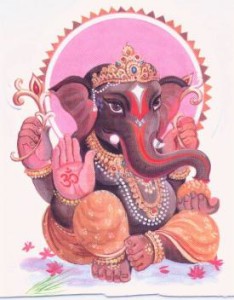 bad, and the ugly. To conquer all obstacles we must accept all obstacles. If we see them as teachers, or as spiritual nourishment (eat your spinach!), we can live fully and freely. It is all ‘us’ anyway. Purnamadah, purnamidam!
bad, and the ugly. To conquer all obstacles we must accept all obstacles. If we see them as teachers, or as spiritual nourishment (eat your spinach!), we can live fully and freely. It is all ‘us’ anyway. Purnamadah, purnamidam!
7. The abhaya mudra (gesture of fearlessness) of his lower right hand symbolizes Ganesh’s blessings and protection on a person’s journey through life, especially the spiritual one. There is always help available if you ask. Ganesh is an aspect of your own higher self, as are all the deitiies, devas and demons, so don’t be shy about asking.
8. In His upper right hand, Ganesh usually holds an axe, with which He is said to cut off all attachments. Anything that prevents you from recognizing your own innate freedom is an attachment. We do not need them. And once you cut them off, they do not necessarily go away immediately. They may hang around, but at least they are no longer stuck to you.
9. He pulls the devotee nearer to the spiritual path by the rope that He carries in His upper left hand. In the beginning we need to be led along, as it is easy to get lost in the world of greed and self-delusion. Teachings, teachers, and the sangha all help herd us along the path.
10. In his lower left hand he holds the rewards he offers for practices (sadhana) done, a 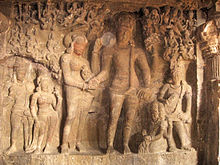 sweet confection known as modak, usually made from rice flour and a stuffing of jaggery, coconut and more. The world of form is divine. Pravati, mother of Ganesh, is the goddess of mothering and nurturing, and mothers want their children to eat well. Parvati, along with Saraswati, goddess of knowledge and learning, and Lakhshmi, goddess of wealth and prosperity, make up the trinity of Indian goddesses. This carving from the Ellora Caves near Aurangabad, India, depicts the marriage of Shiva and Parvati.
sweet confection known as modak, usually made from rice flour and a stuffing of jaggery, coconut and more. The world of form is divine. Pravati, mother of Ganesh, is the goddess of mothering and nurturing, and mothers want their children to eat well. Parvati, along with Saraswati, goddess of knowledge and learning, and Lakhshmi, goddess of wealth and prosperity, make up the trinity of Indian goddesses. This carving from the Ellora Caves near Aurangabad, India, depicts the marriage of Shiva and Parvati.
11. The bowls and baskets of offerings at Ganesh’s feet are there to symbolize that the entire world, and all its choicest pleasures, are out there for the taking. Practice is not self-abnegation. It is celebration of wholeness and fullness, with, discrimination, wisdom and compassion.
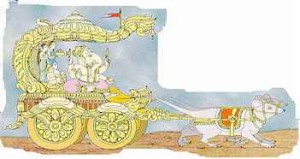 12. Ganesh’s tiny pet and vehicle, Mushika, his mouse, is usually bowing down close by, indicating that though a little desire is good, it is essential for one to master it. You have to ride your desires and not vice versa. How can a huge elephant ride on a tiny mouse? Or be pulled in a chariot by him? Ganesh is very light, in spite of his size and strength. And mushika is pretty strong as well. And Mushika,
12. Ganesh’s tiny pet and vehicle, Mushika, his mouse, is usually bowing down close by, indicating that though a little desire is good, it is essential for one to master it. You have to ride your desires and not vice versa. How can a huge elephant ride on a tiny mouse? Or be pulled in a chariot by him? Ganesh is very light, in spite of his size and strength. And mushika is pretty strong as well. And Mushika, 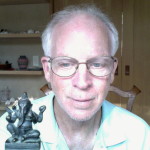 because he is tiny, can carry Ganesha’s grace into every nook and cranny of creation.
because he is tiny, can carry Ganesha’s grace into every nook and cranny of creation.
This week you can invoke your own inner “Ganesh” and see what happens.


